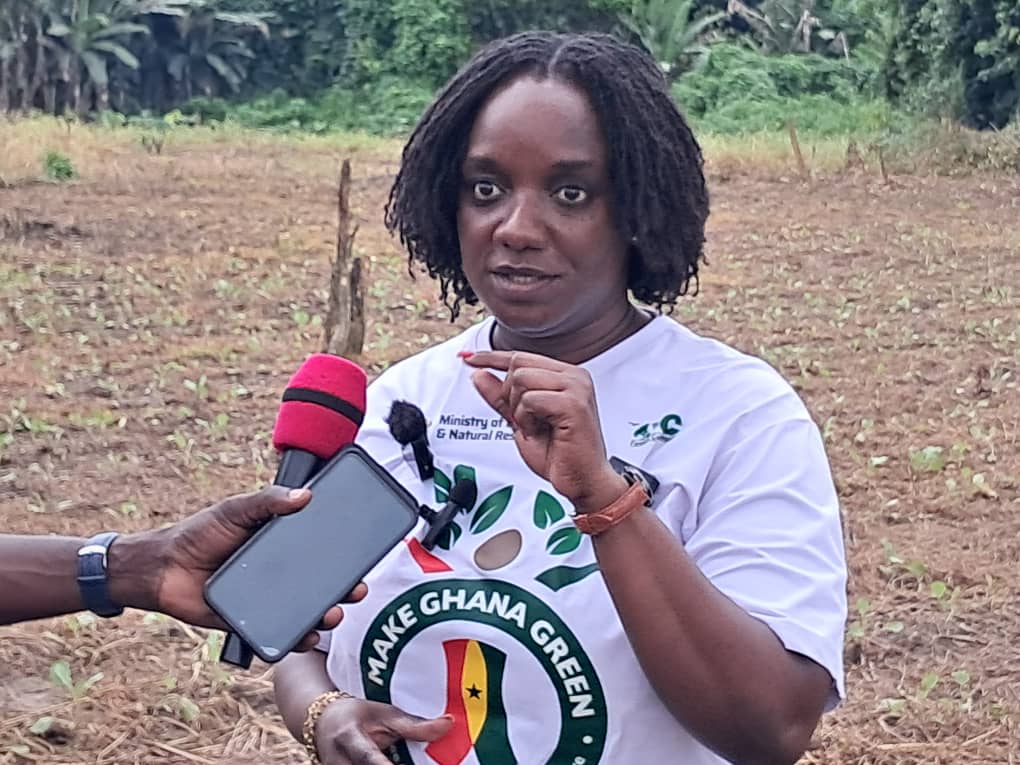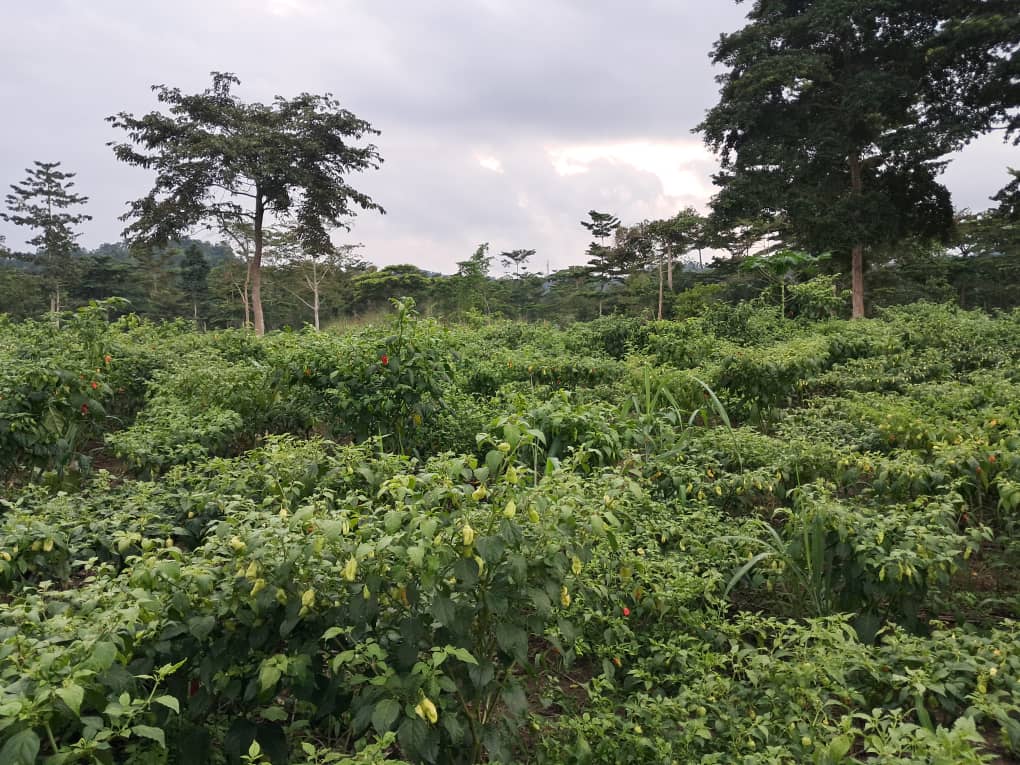When the morning mist settles over the cocoa farms of the Eastern Region, 57-year-old Mary Bampoh, in Akim Potroase, walks through rows of tall, green trees that stretch beyond sight. Her feet brush against fallen cocoa pods, and her eyes light up as she points to new trees growing among her cocoa.
“Before, I harvested only two bags every season,” she said. “Now, I get 15 to 20 bags. My cocoa farm is now money.”

For Mary and thousands of farmers across Ghana, the secret to better harvests is trees.
For decades, cocoa farming has been one of Ghana’s main drivers of deforestation. But that story is changing. Through the United Nations REDD+ initiative — Reducing Emissions from Deforestation and Forest Degradation — farmers are learning to grow cocoa while restoring the very forests their livelihoods depend on.
With support from the Global Landscapes Forum (GLF) and the African Forest Forum (AFF), farmers are being trained to adopt climate-smart agriculture practices that boost productivity while reducing pressure on forests.

“When this initiative came, they built my capacity on many things,” said Collins Akonnor, a cocoa farmer in Atewa West.
“We used to get just a few bags of cocoa. Now, we get much more. It has really helped to reduce poverty in our communities.”
Farmers receive tools such as cutlasses, Wellington boots, pruners, and motorized mist blowers, along with training in alternative livelihoods like beekeeping and mushroom cultivation. These efforts reduce the need to clear more forest for farming.
Planting hope across communities
Across four districts — Atewa East, Atewa West, Abuakwa South, and Denkyembour — more than 21,000 cocoa farmers from 166 communities have benefited from the programme. About 8,000 are women, and over 1,000 are people living with disabilities.
Each acre of a cocoa farm can hold 60 to 70 cocoa trees. Under the REDD+ system, farmers plant at least 20 shade trees per acre, creating a canopy that keeps the soil moist and protects biodiversity.

“They say trees compete with cocoa, but that’s not true,” Mary said. “The shade makes the cocoa grow better, and the environment is cooler.”
Beyond farming, communities are seeing broader improvements. According to a board member at the Forestry Commission’s Hotspot Intervention Areas, Reginald Osei Akoto, the programme has provided eight mechanised boreholes and 549 dual desks for local schools.
“These communities are improving both their livelihoods and their environment,” he said. “We’re seeing real social change because of forest protection.”
Reginald added that Ghana is making steady progress toward its carbon reduction goals.
“In 2019 and 2020, Ghana’s target was to reduce 10,000 tonnes of carbon, and we achieved about 8,000 tonnes. The following years have been even better.”

The bigger picture — Ghana’s cocoa forest REDD+ programme
Launched in 2019, Ghana’s Cocoa Forest REDD+ Programme is the world’s first commodity-based initiative to reduce deforestation caused by cocoa farming.
The programme operates across seven regions — Western, Western North, Central, Bono, Ahafo, Ashanti, and Eastern — identified as Hotspot Intervention Areas (HIAs). Each HIA serves as a unit for local planning and benefit-sharing.
“The goal is to stop cocoa expansion into forest lands and encourage tree planting within cocoa farms,” said Ivy Ashiley, Benefit-Sharing Officer at the Ghana National REDD+ Secretariat.
“This helps reduce deforestation and improves yields at the same time.”
Through REDD+, communities can earn performance-based payments for protecting forests and reducing emissions. The initiative combines environmental protection with social benefits such as education, clean water, and alternative livelihoods.
From local action to global climate goals
The REDD+ initiative is not only transforming cocoa landscapes — it is helping Ghana meet its national and international climate commitments.
Under the Ghana National Climate Change Policy (NCCP) and the country’s Nationally Determined Contributions (NDCs) to the Paris Agreement, Ghana has pledged to reduce greenhouse gas emissions by 64 million tonnes of CO₂ equivalent, create over one million jobs, and avoid 2,900 deaths due to improved air quality by 2030.
Forests play a key role in this target, serving as both carbon sinks and sources of livelihood.

By restoring degraded lands and integrating trees into cocoa farms, Ghana is contributing to global goals under the Paris Agreement, the UN Sustainable Development Goals (SDGs), and the UN Framework Convention on Climate Change (UNFCCC).
Globally, more than 56 countries have adopted REDD+ as a tool to balance development with climate protection — and Ghana’s program is now seen as a model for others to follow.
Partnerships driving change
According to the Regional Coordinator for Africa at the Global Landscapes Forum, Amos Amanubo, Ghana’s progress shows what can happen when farmers, scientists, and policymakers work together.
“The work being done here is inspiring,” he said. “Communities are proving that indigenous knowledge and modern science can work hand in hand to fight climate change.”
The Forestry Commission, Cocoa Board, local governments, and international partners continue to collaborate to ensure sustainability and transparency in benefit sharing — a key principle of REDD+.
Ghana’s cocoa sector serves as a livelihood for over 1.5 million households and contributes billions to the national economy. But for years, its growth came at the cost of forests. Now, through REDD+, farmers are reversing that trend.
“The trees on our farms help the cocoa grow better, protect the environment, and even bring back birds,” Mary said. “We are farming differently now — and we are proud of it.”
As the world faces rising temperatures and shrinking forests, Ghana’s REDD+ story offers a hopeful example: that with the right support, local action can deliver global results.
“Without trees, there is no cocoa. And without cocoa, there is no life for us,” Mary said.
DISCLAIMER: The Views, Comments, Opinions, Contributions and Statements made by Readers and Contributors on this platform do not necessarily represent the views or policy of Multimedia Group Limited.
DISCLAIMER: The Views, Comments, Opinions, Contributions and Statements made by Readers and Contributors on this platform do not necessarily represent the views or policy of Multimedia Group Limited.
Source: myjoyonline.com










